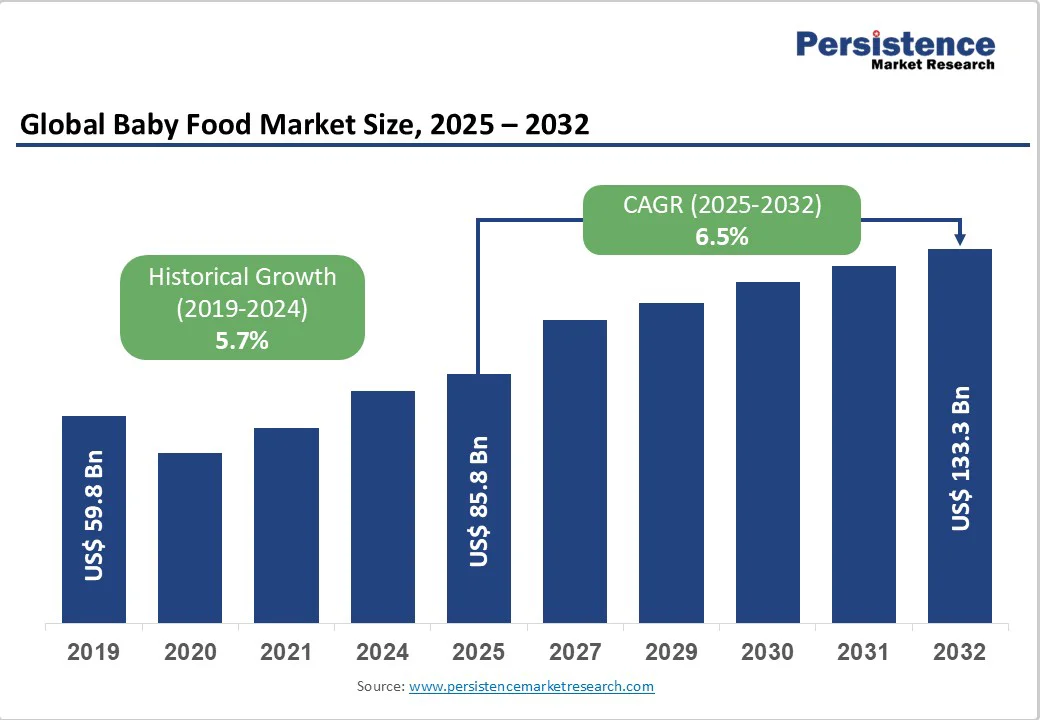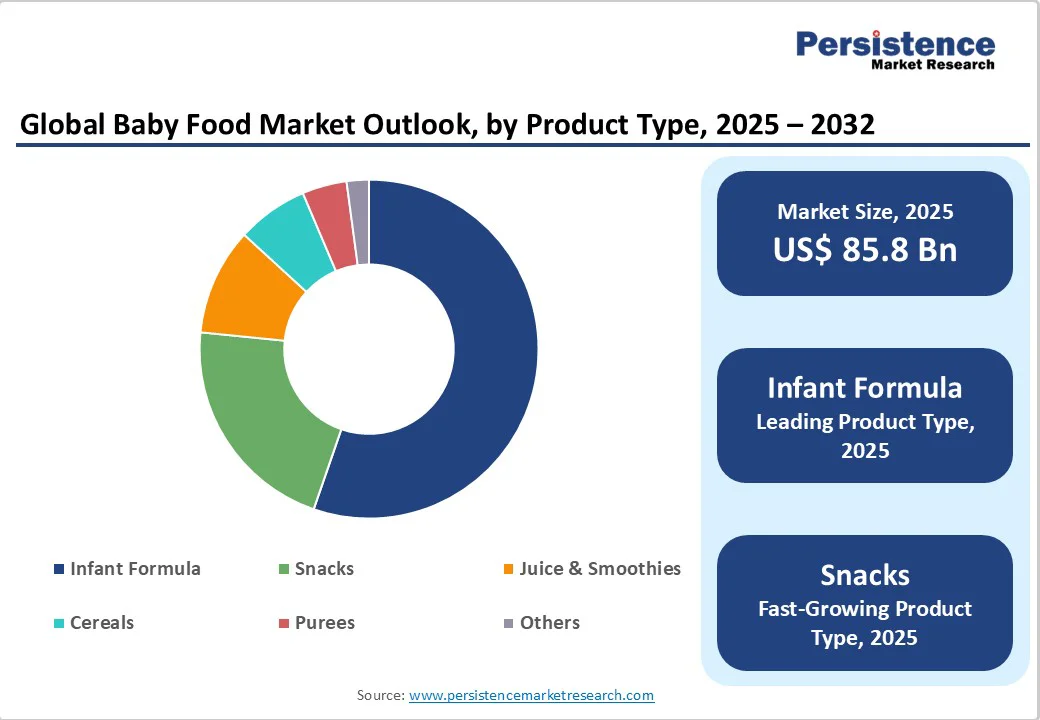ID: PMRREP20881| 197 Pages | 29 Oct 2025 | Format: PDF, Excel, PPT* | Food and Beverages

The global baby food market size is likely to be valued at US$85.8 Bn in 2025 and is projected to reach US$133.3 Bn by 2032, growing at a CAGR of 6.7% during the forecast period from 2025 to 2032. The global baby food market is growing steadily due to rising parental awareness of infant nutrition, increasing disposable incomes, and demand for organic and fortified products.
| Key Insights | Details |
|---|---|
|
Global Baby Food Market Size (2025E) |
US$85.8 Bn |
|
Market Value Forecast (2032F) |
US$133.3 Bn |
|
Projected Growth (CAGR 2025 to 2032) |
6.5% |
|
Historical Market Growth (CAGR 2019 to 2024) |
5.7% |

In India, parental awareness of infant nutrition is significantly influencing the baby food market. The Comprehensive National Nutrition Survey (CNNS) 2016–18 indicates that 58% of infants under six months were exclusively breastfed, highlighting a growing recognition of breastfeeding's importance. Additionally, 53% of infants aged 6–8 months received timely complementary feeding, reflecting an increasing understanding of the need for nutritious solid foods at the appropriate age.
Government initiatives like POSHAN Abhiyaan aim to reduce child stunting, underweight, and low birth weight by 2 percentage points per annum, emphasizing the importance of proper infant nutrition. Furthermore, the National Family Health Survey (NFHS-5) reports that stunting among children under five has decreased from 38.4% to 35.5%, underlining the positive impact of improved nutritional practices. These statistics underscore a growing parental commitment to infant nutrition, driving demand for baby food products that support optimal growth and development.
Health concerns and misinformation significantly impact the baby food market, influencing consumer choices and regulatory actions. A report by the Environmental Defense Fund highlighted the presence of heavy metals like lead, cadmium, and arsenic in commercial baby foods, raising alarms among parents and health professionals about potential developmental risks. Additionally, the proliferation of ultra-processed foods, which often contain high levels of added sugars and artificial additives, has been linked to adverse health outcomes in children.
Misinformation exacerbates these concerns, with misleading marketing claims about product purity and health benefits leading to consumer distrust. For instance, some baby food brands have faced legal actions for falsely advertising their products as free from harmful substances, preying on parents' anxieties.
The growing demand for organic and clean-label baby food presents significant opportunities in India. The Indian organic food market is valued at approximately USD 2.9 billion, with baby food products growing at 5–6% annually. This trend is supported by government initiatives such as the National Program for Organic Production (NPOP), which promotes organic farming standards and certification. Additionally, the Food Safety and Standards Authority of India (FSSAI) has established regulations for infant nutrition, ensuring that products meet safety and quality standards. These developments indicate a robust market potential for organic and clean-label baby food products, aligning with consumer preferences for healthier and more transparent food options.
Infant Formula dominates the market with a 55.3% share in 2025 due to its essential role in providing complete nutrition for infants who are not exclusively breastfed. In India, for instance, the National Family Health Survey (NFHS-5) reports that only 58% of infants under six months are exclusively breastfed. This gap creates a strong reliance on infant formula to meet nutritional requirements, including proteins, vitamins, minerals, and essential fatty acids. Trust in regulated products, pediatrician guidance, and widespread availability make infant formula the preferred choice in both urban and semi-urban regions, reinforcing its market dominance.
Conventional baby food products continue to dominate the market due to their affordability, widespread availability, and established trust among consumers. In India, the Ministry of Food Processing Industries (MoFPI) reports that conventional baby food products, such as infant formula and cereals, account for a significant share of the market, with companies such as Nestlé and Amul leading the segment These products benefit from established supply chains, extensive distribution networks, and strong brand recognition, making them accessible to a broad consumer base. Additionally, government initiatives like the National Program for Organic Production (NPOP) and the Food Safety and Standards Authority of India (FSSAI) regulations have been instrumental in promoting the safety and quality of conventional baby food products. While organic baby food products are gaining traction, they still account for a smaller share of the market due to higher costs and limited availability.

The Asia-Pacific region dominates the global market, accounting for 49.7% in 2025, driven by high birth rates, urbanization, and rising disposable incomes. In India, the Ministry of Food Processing Industries (MoFPI) reports that the baby food sector is expanding rapidly, driven by growing awareness of infant nutrition and increased participation of women in the workforce. Additionally, government initiatives such as the National Program for Organic Production (NPOP) and the Food Safety and Standards Authority of India (FSSAI) regulations have been instrumental in promoting the safety and quality of baby food products. These developments indicate a robust market potential for baby food products in the region.
Europe plays a pivotal role in the global baby food market due to its stringent regulatory standards and robust consumer demand for high-quality infant nutrition products. The European Union enforces comprehensive regulations, such as Regulation (EU) No 1169/2011, which mandates clear labeling and safety standards for infant and follow-on formulas. This regulatory framework ensures that products meet high safety and nutritional standards, fostering consumer trust. Additionally, the European Food Safety Authority (EFSA) provides scientific advice on food safety, contributing to the development of policies that support the availability of safe and nutritious baby foods. These factors make Europe a significant and influential region in the global baby food market.
North America is experiencing rapid growth in the baby food market, driven by several key factors. The U.S. Federal Trade Commission (FTC) reports that over half of the country's infant formula is purchased through the Special Supplemental Nutrition Program for Women, Infants, and Children (WIC), highlighting the significant demand for infant nutrition products. Additionally, the U.S. Food and Drug Administration (FDA) enforces stringent regulations to ensure the safety and nutritional adequacy of infant formula, fostering consumer trust and market stability. The growing preference for organic and clean-label products, coupled with increased health consciousness among parents, further propels market expansion. These factors collectively contribute to North America's position as a rapidly growing region in the global baby food market.

The global baby food market is expanding as manufacturers adopt advanced production, fortification, and packaging techniques. Leading brands focus on nutrition, safety, and shelf stability, while emerging players target organic, allergen-free, and specialty segments. Strategic partnerships, sustainable sourcing, and traceability systems enhance product quality, consumer trust, and distribution, driving higher adoption across urban and semi-urban populations. Innovative ready-to-eat formats, fortified formulas, and clean-label offerings are increasingly preferred by parents seeking convenient, safe, and nutritionally complete solutions for infants and toddlers.
The global Market is projected to be valued at US$ 85.8 Bn in 2025.
Rising parental awareness, urbanization, disposable incomes, demand for organic and fortified products, convenience, e-commerce growth, and health-focused innovation drive the market.
The global baby food market is poised to witness a CAGR of 6.5% between 2025 and 2032.
Growth in emerging markets, organic and clean-label products, fortified foods, e-commerce channels, convenience formats, and innovative toddler-friendly offerings present key opportunities.
Major players in the global baby food market are Nestlé S.A, Danone, Mead Johnson & Company, LLC, Abbott Laboratories, Beech-Nut Nutrition Corp, Nurture, Inc., and Others.
| Report Attribute | Details |
|---|---|
|
Historical Data/Actuals |
2019 - 2024 |
|
Forecast Period |
2025 - 2032 |
|
Market Analysis |
Value: US$ Bn Volume: Tons |
|
Geographical Coverage |
|
|
Segmental Coverage |
|
|
Competitive Analysis |
|
|
Report Highlights |
|
By Product Type
By Nature
By Distribution Channel
By Region
Delivery Timelines
For more information on this report and its delivery timelines please get in touch with our sales team.
About Author